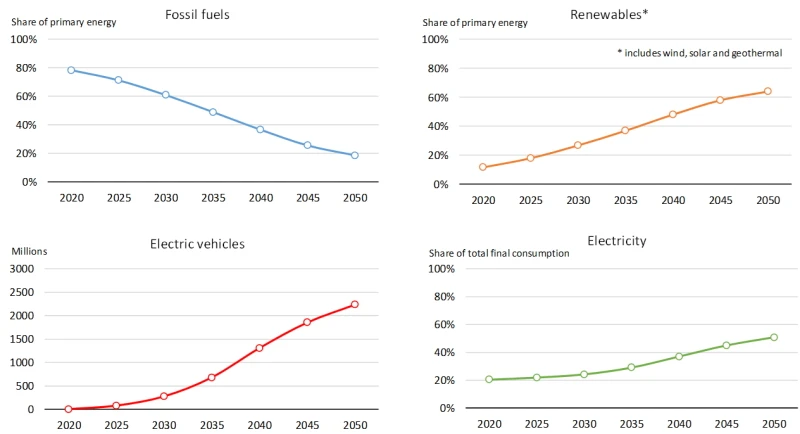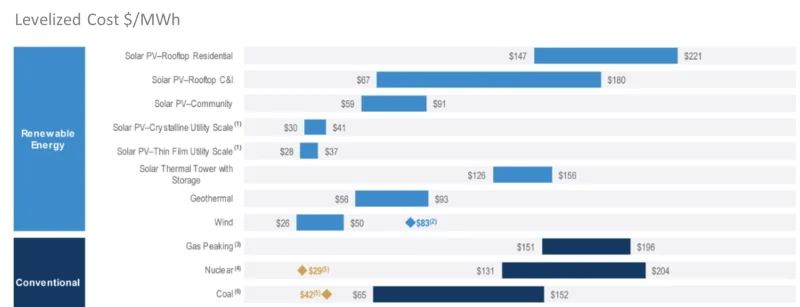Energy markets – in transition but far from sustainable
Energy is critical for economic growth, but it is dominated by fossil fuels. Oil, coal and gas account for more than 80% of the primary energy needed to power the world’s economies. The Paris Agreement and the transition to a net-zero economy mean the shift to renewables and other low-carbon sources will accelerate in the next decade and ultimately supplant fossil fuels’ preeminence. But though momentum has increased, we cannot get there fast enough.
With 80% of total CO2 emissions, we always knew the energy sector was dirty. But the recent convergence of crises has underscored additional dangers. It is extremely inefficient; 60% of the fossil fuels extracted are wasted, with half lost in the production of electricity, and another half lost when fuels are inefficiently burned during combustion. It is highly vulnerable due to dangerous dependencies on countries rich in fossil fuels but poor at diplomacy and governance. And it is volatile; the conflict in Ukraine took energy markets off-guard, amplifying the rise in energy prices.
“
In order to limit extreme global warming, nearly 75% of global electricity generation must come from low-emission sources by 2030
Clean energy requires electrification of consumption
Decarbonizing can only happen when burning hydrocarbons in engines and furnaces is replaced with racing electrons in a circuit. But that future reality depends not only on producing clean energy via renewables but also on clean consumption downstream via electric end-use applications (See Figure 1).
In order to limit extreme global warming, nearly 75% of global electricity generation must come from low-emission sources by 2030. Currently, wind and solar account for only 6% of the global mix. To reach net zero, electricity consumption needs to outgrow energy consumption by a factor of two to three in the coming decades. This will be driven not only by transport markets (via lithium-ion batteries, vehicle powertrains, green hydrogen and passenger railways), but also buildings (via electric heat pumps, HVAC and insulation), and industrial markets (via the electrification of production processes).
The world’s largest economies have already set ambitious targets to increase the share of renewables in the national energy mix, including the US where the recently passed Inflation Reduction Act (IRA) devotes nearly USD 400 billion to building up domestic renewable energy production and storage as well as clean energy use by consumers.
Figure 1 | Synchronized solutions – renewable energy supplies rise to support electric consumption

Renewable energy supplies will increase to support the electrification of end use applications.
Source: BP outlook
Driving not derailing the energy transition
Meanwhile, energy security has replaced climate security as an immediate concern, especially for Europe. Russia has cut EU gas supplies as tensions over the war in Ukraine have escalated, leaving the EU desperate for energy to keep its lights on, its citizens warm and its economies churning.
In the short term, countries are reverting to fossil fuels to fill the gap, but as geopolitical tensions tighten, the crisis emphasizes the high-stakes jeopardy of an economy dependent on fossil fuels. Recognizing this, the EU has acted swiftly to further accelerate its net-zero path. Its “REPowerEU” plan further cuts energy emissions, boosts electrification of buildings and industries, and expands investment in renewable supplies and infrastructure connections across bloc economies.
But the trade-offs between energy security and climate security are complicated by current technological capacity but also political will and public sentiment, especially if consumers are forced to ration.
不為人知的能源轉型事實
釋放智慧能源的力量!
High energy costs create incentives
Per the International Energy Agency, in order to reach net-zero emissions by 2050, annual investment needs to double to USD 5 trillion a year. Energy costs comprise a significant share of total expenses in a variety of business models, which means a company’s energy savings often have an outsized effect on the bottom line.
The benefits of transitioning will accrue in the long term, but over the short term many firms will see significant costs, especially in hard-to-electrify industries. However, renewable production costs are falling relative to traditional energy forms (see Figure 2). And with traditional energy costs exploding, consumers and energy-intensive industries will accelerate their own energy transitions as payback periods for investments in renewable energy procurement and energy-efficient solutions shorten.
Figure 2 | Renewables – cost competitive in industry and residential settings

The levelized cost of energy from renewable sources (solar installations, geothermal and wind) are competitive and in industrial settings much lower than conventional forms of energy such as gas, coal and nuclear.
Source: Lazard
Targeted investment in electrification
Despite present challenges, electrification is at the beginning of a huge investment cycle which will spill across sectors. We believe we are reaching a turning point where governments will stop incentivising combustible fuels and encourage the adoption of technologies that facilitate economies running fully on electricity. As the fuel mix diversifies and customers are granted more flexibility, competition between energy sources will increase. This will further accelerate economy-wide shifts in renewables and electrification.
The Smart Energy team invests in companies enabling and accelerating the transition along the entire electrification value chain – from upstream companies supporting the generation of renewable wind and solar power to mid- and downstream companies creating more efficient ways to use, store and distribute it. Alongside investments in maturing technologies, the team is continuously looking for companies that can simplify and scale production of breakthrough solutions that will further accelerate the electrification of the economy.
免責聲明
本文由荷宝海外投资基金管理(上海)有限公司(“荷宝上海”)编制, 本文内容仅供参考, 并不构成荷宝上海对任何人的购买或出售任何产品的建议、专业意见、要约、招揽或邀请。本文不应被视为对购买或出售任何投资产品的推荐或采用任何投资策略的建议。本文中的任何内容不得被视为有关法律、税务或投资方面的咨询, 也不表示任何投资或策略适合您的个人情况, 或以其他方式构成对您个人的推荐。 本文中所包含的信息和/或分析系根据荷宝上海所认为的可信渠道而获得的信息准备而成。荷宝上海不就其准确性、正确性、实用性或完整性作出任何陈述, 也不对因使用本文中的信息和/或分析而造成的损失承担任何责任。荷宝上海或其他任何关联机构及其董事、高级管理人员、员工均不对任何人因其依据本文所含信息而造成的任何直接或间接的损失或损害或任何其他后果承担责任或义务。 本文包含一些有关于未来业务、目标、管理纪律或其他方面的前瞻性陈述与预测, 这些陈述含有假设、风险和不确定性, 且是建立在截止到本文编写之日已有的信息之上。基于此, 我们不能保证这些前瞻性情况都会发生, 实际情况可能会与本文中的陈述具有一定的差别。我们不能保证本文中的统计信息在任何特定条件下都是准确、适当和完整的, 亦不能保证这些统计信息以及据以得出这些信息的假设能够反映荷宝上海可能遇到的市场条件或未来表现。本文中的信息是基于当前的市场情况, 这很有可能因随后的市场事件或其他原因而发生变化, 本文内容可能因此未反映最新情况,荷宝上海不负责更新本文, 或对本文中不准确或遗漏之信息进行纠正。
